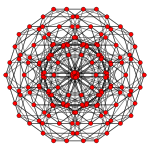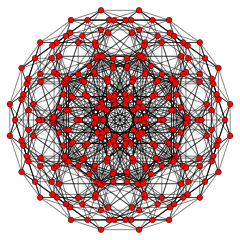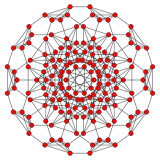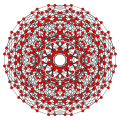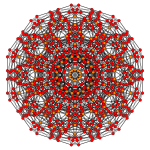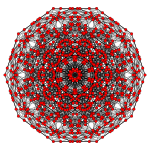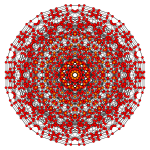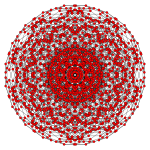5-cube
| 5-cube penteract (pent) | ||
|---|---|---|
| Type | uniform 5-polytope | |
| Schläfli symbol | {4,3,3,3} {4,3,3}×{ } {4,3}×{4} {4,3}×{ }×{ } {4}×{4}×{ } {4}×{ }×{ }×{ } { }×{ }×{ }×{ }×{ } | |
| Coxeter-Dynkin diagram | ||
| 4-faces | 10 | tesseracts |
| Cells | 40 | cubes |
| Faces | 80 | squares |
| Edges | 80 | |
| Vertices | 32 | |
| Vertex figure |  5-cell | |
| Coxeter group | BC5, [4,33], order 3840 [4,3,3,2], order 768 [4,3,2,4], order 384 [4,3,2,2], order 192 [4,2,4,2], order 128 [4,2,2,2], order 64 [2,2,2,2], order 32 | |
| Dual | 5-orthoplex | |
| Base point | (1,1,1,1,1,1) | |
| Circumradius | sqrt(5)/2 = 1.118034 | |
| Properties | convex, isogonal regular | |
In five-dimensional geometry, a 5-cube is a name for a five dimensional hypercube with 32 vertices, 80 edges, 80 square faces, 40 cubic cells, and 10 tesseract 4-faces.
It is represented by Schläfli symbol {4,33}, constructed as 3 tesseracts, {4,3,3}, around each cubic ridge. It can be called a penteract, a portmanteau of tesseract (the 4-cube) and pente for five (dimensions) in Greek. It can also be called a regular deca-5-tope or decateron, being a 5-dimensional polytope constructed from 10 regular facets.
Related polytopes
It is a part of an infinite hypercube family. The dual of a 5-cube is the 5-orthoplex, of the infinite family of orthoplexes.
Applying an alternation operation, deleting alternating vertices of the 5-cube, creates another uniform 5-polytope, called a 5-demicube, which is also part of an infinite family called the demihypercubes.
Cartesian coordinates
Cartesian coordinates for the vertices of a 5-cube centered at the origin and edge length 2 are
- (±1,±1,±1,±1,±1)
while the interior of the same consists of all points (x0, x1, x2, x3, x4) with -1 < xi < 1.
Images
n-cube Coxeter plane projections in the Bk Coxeter groups project into k-cube graphs, with power of two vertices overlapping in the projective graphs.
| Coxeter plane | B5 | B4 / D5 | B3 / D4 / A2 |
|---|---|---|---|
| Graph |  |
 |
 |
| Dihedral symmetry | [10] | [8] | [6] |
| Coxeter plane | Other | B2 | A3 |
| Graph |  |
 |
 |
| Dihedral symmetry | [2] | [4] | [4] |
 Wireframe skew direction |
 B5 Coxeter plane |
 Vertex-edge graph. |
 A perspective projection 3D to 2D of stereographic projection 4D to 3D of Schlegel diagram 5D to 4D. |
 Animation of a 5D rotation of a 5-cube perspective projection to 3D. |
Related polytopes
This polytope is one of 31 uniform polytera generated from the regular 5-cube or 5-orthoplex.
References
- H.S.M. Coxeter:
- Coxeter, Regular Polytopes, (3rd edition, 1973), Dover edition, ISBN 0-486-61480-8, p. 296, Table I (iii): Regular Polytopes, three regular polytopes in n-dimensions (n≥5)
- Kaleidoscopes: Selected Writings of H.S.M. Coxeter, editied by F. Arthur Sherk, Peter McMullen, Anthony C. Thompson, Asia Ivic Weiss, Wiley-Interscience Publication, 1995, ISBN 978-0-471-01003-6
- (Paper 22) H.S.M. Coxeter, Regular and Semi Regular Polytopes I, [Math. Zeit. 46 (1940) 380-407, MR 2,10]
- (Paper 23) H.S.M. Coxeter, Regular and Semi-Regular Polytopes II, [Math. Zeit. 188 (1985) 559-591]
- (Paper 24) H.S.M. Coxeter, Regular and Semi-Regular Polytopes III, [Math. Zeit. 200 (1988) 3-45]
- Norman Johnson Uniform Polytopes, Manuscript (1991)
- N.W. Johnson: The Theory of Uniform Polytopes and Honeycombs, Ph.D. (1966)
- Richard Klitzing, 5D uniform polytopes (polytera), o3o3o3o4x - pent
External links
- Weisstein, Eric W., "Hypercube", MathWorld.
- Olshevsky, George, Measure polytope at Glossary for Hyperspace.
- Multi-dimensional Glossary: hypercube Garrett Jones
| Fundamental convex regular and uniform polytopes in dimensions 2–10 | ||||||||||||
|---|---|---|---|---|---|---|---|---|---|---|---|---|
| Family | An | BCn | I2(p) / Dn | E6 / E7 / E8 / F4 / G2 | Hn | |||||||
| Regular polygon | Triangle | Square | p-gon | Hexagon | Pentagon | |||||||
| Uniform polyhedron | Tetrahedron | Octahedron • Cube | Demicube | Dodecahedron • Icosahedron | ||||||||
| Uniform polychoron | 5-cell | 16-cell • Tesseract | Demitesseract | 24-cell | 120-cell • 600-cell | |||||||
| Uniform 5-polytope | 5-simplex | 5-orthoplex • 5-cube | 5-demicube | |||||||||
| Uniform 6-polytope | 6-simplex | 6-orthoplex • 6-cube | 6-demicube | 122 • 221 | ||||||||
| Uniform 7-polytope | 7-simplex | 7-orthoplex • 7-cube | 7-demicube | 132 • 231 • 321 | ||||||||
| Uniform 8-polytope | 8-simplex | 8-orthoplex • 8-cube | 8-demicube | 142 • 241 • 421 | ||||||||
| Uniform 9-polytope | 9-simplex | 9-orthoplex • 9-cube | 9-demicube | |||||||||
| Uniform 10-polytope | 10-simplex | 10-orthoplex • 10-cube | 10-demicube | |||||||||
| Uniform n-polytope | n-simplex | n-orthoplex • n-cube | n-demicube | 1k2 • 2k1 • k21 | n-pentagonal polytope | |||||||
| Topics: Polytope families • Regular polytope • List of regular polytopes | ||||||||||||










